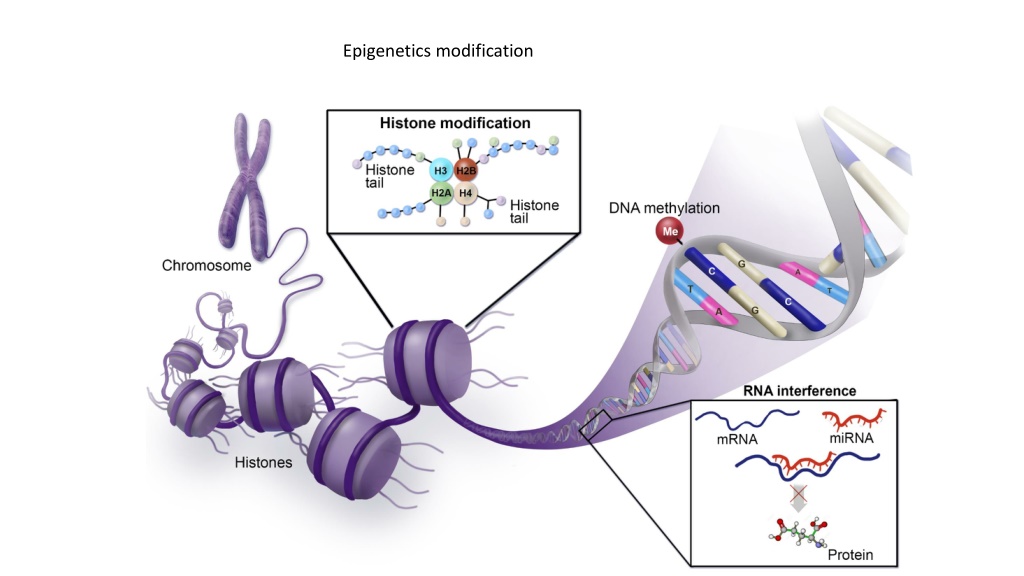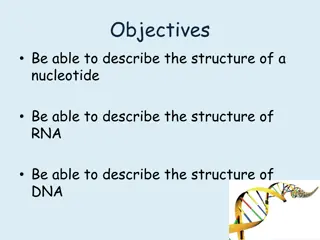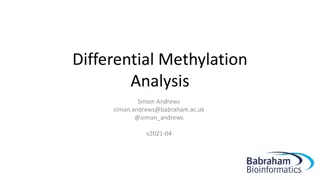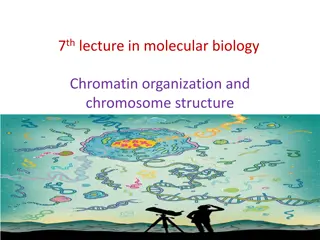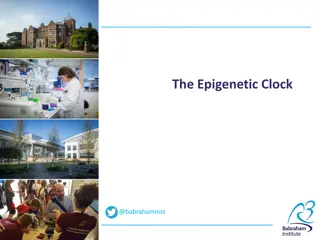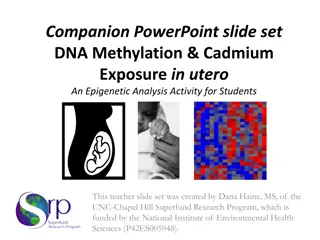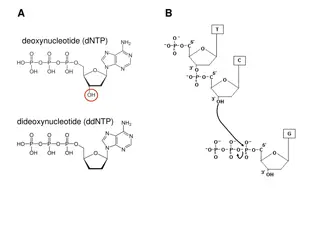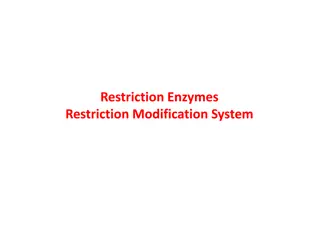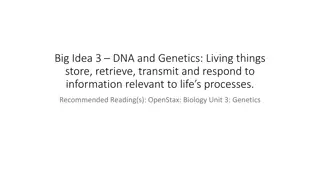Understanding Epigenetics: DNA Methylation and Histone Modification
Epigenetics refers to changes in gene expression without altering the DNA sequence. This involves processes like DNA methylation, histone modification, and microRNAs. DNA methylation is controlled by DNA methyltransferase enzymes and plays crucial roles in gene activation and silencing. Histone modification, including phosphorylation and methylation, also influences chromatin structure. Drugs like 5-aza-CdR and antisense oligonucleotides are used in clinical trials to target DNA methylation. Understanding these epigenetic modifications is vital in studying gene regulation mechanisms.
Download Presentation

Please find below an Image/Link to download the presentation.
The content on the website is provided AS IS for your information and personal use only. It may not be sold, licensed, or shared on other websites without obtaining consent from the author. Download presentation by click this link. If you encounter any issues during the download, it is possible that the publisher has removed the file from their server.
E N D
Presentation Transcript
Epigenetics modification: Changing in gene expression without affecting the primary DNA sequence. Epigenetic modification including DNA methylation, histone modification and micro RNAs. DNA methylation is an epigenetic modification that occurs as a result of a biological mechanism that leads to the attachment of a methyl group onto the 5thcarbon of cytosine (5mC).
DNA methylation processes are controlled by the DNA methyltransferase enzyme (DNMTs) family, which create 5 methylcytosine (5mC) via transferring a methyl group from a donor S- adenine methionine (SAM) to the 5th carbon of cytosine. Hypomethylation is a process that leads to gene activation (oncogenes). Hypermethylated is a process that leads to gene inactivation (Tumor suppressor genes). which suggested an increase of DNMTs enzymes activity in cancer cells compared to normal cells. (A) Methylation at 5 position of cytosine moiety, catalyzed by DNMT, in the presence of S-adenosyl-methionine (SAM). (B) Unmethylated CpGs within the promoter regulation region (dark brown) do not prevent transcription, gene is expressed. When the DNA methylation of CpGs within the promoter, gene becomes silenced.
A- DNMT1 attaches methyl groups to the hemimethylated DNA during replication. B- DNMT3A and DNMT3B can bind methyl groups to CpG dinucleotides of unmethylated DNA.
Methylation and gene expression: Two mechanism contribute to gene silencing: 1- DNA methylation prevents the binding of transcription factors to their binding sites within promoter sequence. 2- Inhibition the binding of transcription factor via recruiting m5CpG-binding (MeCP) and m5CpG-binding domain (MBD) proteins. inhibition of transcription via CpG dinucleotide methylation. A- Promoter sequence binds transcription factors (TFs) and RNA polymerase II (POL II) that initiates transcription. B- Methylation of CpG within promoter binding site directly inhibits TFs binding and represses transcription. C- Methylated DNA binds m5CpG binding (MeCPs) and m5CpG-binding domain (MBDs) proteins forming spatial obstacle that prevents binding of TFs to promoter sequence.
Drugs used in clinical trial: 5-Aza-2 - deoxycytidine (5-aza-CdR) and 5-azacytidine which is incorporated into DNA and inactivates DNMTs. Antisense oligonucleotide which induces degradation of DNMT1 mRNA and inhibits enzyme biosynthesis.
Histone modification: Histone proteins (H2A, H2B, H3 and H4) have N- and C- terminals that form histone tails, where post-translation modifications often take place causing changes of chromatin structure, including phosphorylation, methylation, and acetylation. Histone acetylation: Histone acetyl transferase (HAT): tend to add acetyl group on lysine residue on histone tail, which leads to chromatin becoming permissive and as a consequence a transcription process takes place. Histone deacetylase (HDAC): tend to remove an acetyl group, causing stability of chromatin structure and expression inhibition.
Acetyl group remove + charge Decrease interaction between histone and negatively charged DNA packed chromatin converts to unpacked chromatin Increase Gene expression
Drugs used in clinical trial: Two HDAC inhibitors: vorinostat and depsipeptide Vorinostat causes a HDAC inhibition. Consequently, increase the expression of tumor suppressor gene
MicroRNAs: MicroRNAs (miRNAs), belong to a non-coding RNA family and consist of 17-25 nucleotides. miRNAs epigenetically contribute in governing gene expression in various pathways, for instance miRNA expression may be controlled by epigenetic mechanisms, miRNAs are involved in inhibition of some epigenetic elements, or cooperation between miRNA and epigenetic elements is required to achieve a specific task. In addition, some of 50% miRNAs, that are placed in CpG islands, have been regulated by DNA methylation and they were abnormally expressed in different tumours including miR-31 (breast cancer) and miR-124a (colon cancer).
miRNAs involvtranslational repression or degradation of the target mRNA (messenger RNA). miRNAs are a class of short, non-coding, single-stranded RNA molecules, approximately 22 nucleotides in length, that negatively regulate gene expression at the post-transcriptional level. They bind sequences in the target messenger RNA through complementarity and form RNA-RNA complex.
Differentially microRNAs) in various diseases expressed microRNAs (signature Overview of microRNAs therapeutics development status
In cancer, epigenetic changes happen in two Pathways: Genes that are expressed in natural cells, such as tumor suppressor genes. During tumorigenesis (cancer initiation), the genes are possibly turned off via: Through histone modification such as histone deactylation or de novo methylation of the DNA or miRNA interference. So, inhibition of the expression that induced by HDSA can be treated with HDAC inhibitors such as vorinostat, and the de novo methylation function can be reversed through DNA Methylation inhibitors (DNMTi) such as 5- Aza-CR. Also, abnormal miRNAs can be treated as well. Combined chemotherapy and epigenetic inhibitor treatment may help to deliver a better treatment to patients.
